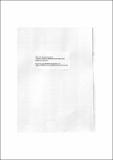| dc.contributor.author | Gorham, A. B. | |
| dc.date.accessioned | 2011-10-07T15:19:31Z | |
| dc.date.available | 2011-10-07T15:19:31Z | |
| dc.date.issued | 1977-01 | |
| dc.identifier.citation | Gorham, A. B. (1977) Developments in primary education in Kajiado district 1963-1975. Working paper no. 297, Nairobi: Institute for Development Studies, University of Nairobi | en_GB |
| dc.identifier.uri | https://opendocs.ids.ac.uk/opendocs/handle/20.500.12413/1169 | |
| dc.description.abstract | This paper traces the expansion of first level educational facilities in Kajiado District (one of the two administrative areas comprising Kenya Maasailand) since Independence. With the history of formal education in the area characterized largely by widespread Maasai resistance to schooling, demand for such services has emanated primary from non-Maasai ethnic groups who traditionally, have controlled the major trading centres (Townships) or engaged in agriculture in the principal high potential regions around Ngong and Loitokitok. In these two widely separated areas relatively dense networks of well attended primary schools have emerged and this in turn has tended to facilitate both educational administration and supervision in both regions. In the pastoral interior however (and despite a substantial increase in first level facilities since the mid 1960’s) the education system remains under-developed. Most of these schools terminate at Std.V or below and many are virtually cut off from contact either with other schools or with District and Divisional Education Offices and personnel, Moreover Maasai participation in those schools is directly affected by the traditional herding requirements associated with the prevailing pastoral economy and the inability, thus far, to link formal education to improved economic conditions in the traditional sector has meant that most Maasai parents refuse to regard educational expenditure in investment terms. Thus while the expansion of primary facilities in the past decade has been greatest in those areas where educational resistance has been most pronounced, the majority of these schools have had difficulty in going beyond the Std.4 or Std. 5 1eve1. In Ngong & Loitokitok on the other hand almost all tin schools are full primaries (i.e. Std.7), enjoying some measure of local support, together with periodic supervision from nearby Divisional Headquarters. It is primarily in these schools both rural and Township-that the recent substantial enrolment increases in the district have been registered | en_GB |
| dc.language.iso | en | en_GB |
| dc.publisher | Institute for Development Studies, University of Nairobi | en_GB |
| dc.relation.ispartofseries | Working Papers.;297 | |
| dc.rights.uri | http://creativecommons.org/licenses/by-nc-nd/3.0/ | en_GB |
| dc.subject | Education | en_GB |
| dc.title | Developments in primary education in Kajiado district 1963-1975 | en_GB |
| dc.type | Series paper (non-IDS) | en_GB |
| dc.rights.holder | Institute for Development Studies, University of Nairobi | en_GB |
| dc.identifier.blds | 316631 | |


